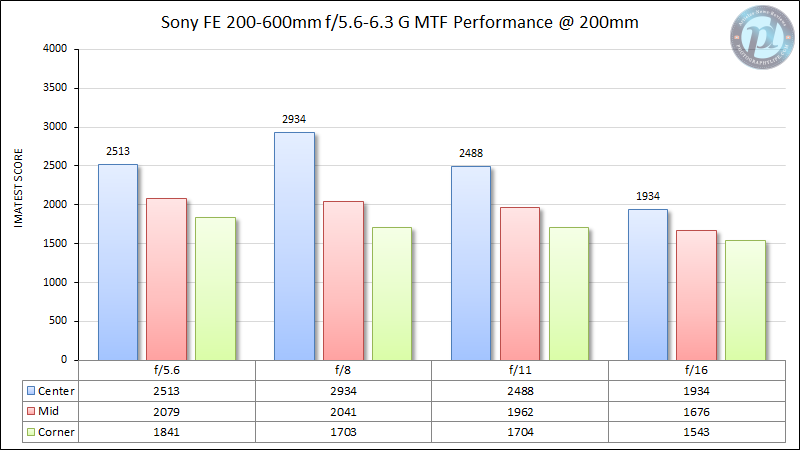Sony 200-600mm f/5.6-6.3 G Compared
There are a few alternatives to the Sony 200-600mm f/5.6-6.3 that are worth considering, most notably the Sigma 150-600mm and Tamron 150-500mm lenses. Sony also has a relatively new 400-800mm f/6.3-8 lens that we have not yet tested in the lab. Below are some comparisons at a variety of focal lengths to give you a sense of how the Sony FE 200-600mm f/5.6-6.3 G compares.
200mm



At 200mm, the three lenses being compared here are all pretty good. The highest central sharpness is achieved by the Sony at f/8, although the other two lenses aren’t far behind. Meanwhile, the maximum midframe and corner sharpness on all three lenses is within 10% of one another, which is approximately the threshold of what’s visible to a trained eye.
300mm

At 300mm, the story is very similar. All three of these lenses are on approximately the same level, but the Sony does eke out an advantage in central sharpness. The midframes actually measure a hair better on the Tamron, although it’s on the margin of what’s visible in practice or not. Meanwhile, corner sharpness on all three lenses remains similar enough not to matter.
400mm



The differences are a little greater at 400mm, although all three lenses are still roughly on the same level. The Sony’s sharpness in the center remains, although the Nikon has improved enough that it’s within striking distance. Midframes still favor the Tamron, surprisingly, although likely still not by enough to matter. Meanwhile, the Tamron has lost considerable sharpness in the far corners at 400mm. It’s still not awful, but both the Nikon and the Sony are meaningfully sharper in that portion of the frame.
500mm



At 500mm, I wouldn’t say that the story is particularly different. In the center, the Sony 200-600mm remains the sharpest, although its lead has shrunk a little. In the midframes, the Tamron still technically is the sharpest in a lab, but all three lenses are effectively equivalent. As for the corners, the Sony and Nikon are once again on about the same level, but the Tamron has dropped a bit more. Granted, far corner sharpness often isn’t important at such long focal lengths, but of the three, I’d still prefer either the Sony or the Nikon at 500mm (with perhaps just the slightest preference for the Sony).
600mm


I’m still pretty early on my journey to test all Sony FE lenses in the lab, so unfortunately, I don’t have any other native 600mm lenses to show here for comparison. Nevertheless, our Sony test results can be directly compared against our Nikon test results to show you in a relative sense how the lenses perform.
Here, at 600mm, the Nikon and the Sony are on a very similar level. The Sony continues its reign as the central sharpness champion, but in this case, the differences are so small as to be irrelevant for most users. Midframe sharpness also favors the Sony, this time by a little more meaningful amount. Finally, corner sharpness is a hair better on the Nikon at f/6.3 and f/8, but the differences are even smaller than they were in the center.
I would give the slightest of edges to the Sony at 600mm, mainly because the midframe sharpness differences could be enough to see if you zoom into 400%. But this is about as similar as I’ve ever seen two lenses from different manufacturers perform. Frankly, both lenses are pretty much interchangeable in sharpness, to the point that the normal amount of sample variation probably matters more than the innate qualities of either lens’s design. (Of course, it’s ultimately irrelevant, because you should just buy whatever lens fits your mount – but let’s just say that neither Sony nor Nikon shooters should switch brands over the differences shown here.)
Over time, as I test more Sony telephoto lenses in the lab, I will add them to our list of reviews so that you can compare them directly against the FE 200-600mm f/5.6-6.3 G.
The next page of this review sums up everything and explains the pros and cons of the Sony FE 200-600mm f/5.6-6.3 G. So, click the menu below to go to “Verdict”:
Table of Contents

